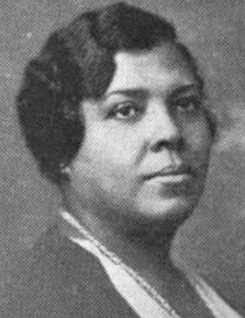Daisy Elizabeth Adams Lampkin facts for kids
Quick facts for kids
Daisy Elizabeth Adams Lampkin
|
|
|---|---|

Daisy E. Lampkin, from a 1936 magazine
|
|
| Born |
Daisy Elizabeth Adams
August 9, 1883 Reading, Pennsylvania, U.S.
|
| Died | March 10, 1965 (aged 81) |
| Occupation | Activist, suffragist, clubwoman |
| Spouse(s) |
William Lampkin
(m. 1912) |
Daisy Elizabeth Adams Lampkin (August 9, 1883 – March 10, 1965) was an important American activist. She worked for women's right to vote (called a suffragist) and for civil rights. Daisy Lampkin was a great speaker, good at raising money, and a strong organizer. She helped many groups like the National Association of Colored Women (NACW) and the National Association for the Advancement of Colored People (NAACP). Her work helped shape the fight for equality for over 50 years.
Contents
Early Life and Activism
Daisy Elizabeth Adams was born on August 9, 1883, in Reading, Pennsylvania. She went to school there. Her parents were George Adams and Rose Proctor. Her grandparents, Joseph Jenifer Proctor and Elizabeth Swann, were free people of color.
In 1909, Daisy moved to Pittsburgh, Pennsylvania. She married William Lampkin in 1912. He owned a restaurant. Living in Pittsburgh, Daisy became very interested in social justice. She especially cared about issues affecting African-American women and families.
Fighting for the Right to Vote
Inspired by the movement for women's voting rights, Daisy started holding meetings at her home in 1912. She joined a group called the New Negro Women's Equal Franchise Federation. This group later changed its name to the Lucy Stone League. Daisy gave speeches on street corners. She also encouraged other Black housewives to join consumer groups.
Her strong leadership and speaking skills led her to become president of the Lucy Stone League in 1915. She held this important role until 1955.
Leading Women's Clubs
During this time, Daisy also became deeply involved with Black women's clubs across the country. She became a leader in the National Association of Colored Women (NACW). She even became the National Board Chairwoman. She made friends with other key leaders like Mary Church Terrell and Addie Waites Hunton.
Her most important friendship was with Mary McLeod Bethune. Together, they helped start the National Council of Negro Women (NCNW) in 1935. This group worked to improve the lives of Black women.
Working for Civil Rights
After women won the right to vote, Daisy Lampkin focused more on civil rights. She worked at both local and national levels. She led the Allegheny County Negro Women's Republican League. She also helped lead the Negro Voters League of Pennsylvania.
She started the first Red Cross chapter for Black women. She also helped set up local chapters of the Urban League and the NAACP in Pittsburgh.
The Pittsburgh Courier
Daisy Lampkin became a part-owner and vice-president of the Pittsburgh Courier newspaper. She used the newspaper to raise money for social justice causes. Under her leadership, the Pittsburgh Courier became the most widely read African-American newspaper in the world by the 1950s.
Her influence grew so much that she met with President Calvin Coolidge at the White House in 1924. They discussed racial equality. Daisy was the only woman at this important meeting.
Field Secretary of the NAACP
In 1930, Walter White, the national secretary of the NAACP, asked Daisy Lampkin to join the organization. She became the NAACP's first field secretary. Her work to organize and strengthen the NAACP across the country was amazing.
In 1931, she single-handedly organized the NAACP's national meeting in Pittsburgh. Her skills in fundraising and organizing impressed the NAACP leaders. In 1935, she became the National Field Secretary.
Fighting Against Lynching
That same year, Daisy Lampkin and Walter White led the NAACP's effort to pass a federal anti-lynching bill. This bill aimed to make lynching a federal crime. Daisy was very involved in lobbying for the bill. She also raised a lot of money for the cause, even during the Great Depression.
Daisy was known for being a strong, no-nonsense activist. She spoke out when white anti-lynching groups did not fully support the federal bill. She believed their silence helped those who opposed the bill.
Lasting Impact
Daisy Lampkin did much more than just lobbying and fundraising. She is also known for recruiting a young lawyer named Thurgood Marshall to the NAACP's Legal Defense Committee in 1938. Marshall later became a Supreme Court Justice. He led the NAACP's successful fight in the Brown vs. Board of Education case, which ended segregation in schools.
Daisy Lampkin helped the NAACP gain more members than any other leader. In her last year as National Field Secretary, she raised over $1 million for the organization. She was so dedicated that she once visited 40 NAACP chapters in one month.
She also helped the Delta Sigma Theta sorority with their fundraising and organizing. She helped them become more involved in national policy-making. She was made an Honorary Member of the sorority in 1947.
Death
Daisy Lampkin stopped being the National Field Secretary in 1947. However, she continued to serve on the NAACP's executive board. She had a stroke during an NAACP membership drive in Camden, New Jersey. She passed away on March 10, 1965.
A special marker in Pittsburgh, Pennsylvania, remembers her achievements. She is buried at Homewood Cemetery in Pittsburgh.

